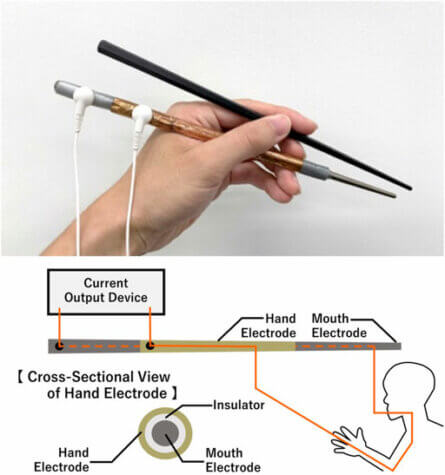TOKYO — Shocking new research from Japan may help countless people reduce their salt intake. Scientists report electrical stimulation of the tongue using a chopstick-shaped utensil can increase the perceived saltiness (and maybe savoriness) of low-sodium foods.
An experiment involving human volunteers found that this chopstick electroshock tastebud therapy may lead to a 30-percent reduction in salt consumption. While a shock to the tongue certainly doesn’t sound nice, researchers assure the electrical current is quite weak.
Countless people eat way too much salt. We put it on our dinners, snacks, and everything in between. While a little bit of salt is tasty, too much can be harmful. The most common health issue connected to consuming excess salt is hypertension. Moreover, according to the World Health Organization, an astounding 2.5 million deaths each year may be preventable if the world cut its salt consumption down to the recommended amount of less than five grams daily.
This research, conducted by scientists at Meiji University and Kirin, a Japanese food and beverage company, may help millions adhere to a low sodium diet without sacrificing taste. The research team’s newly conceived chopstick-like device makes use of a weak electrical charge to stimulate and change how the tongue experiences saltiness.

What does electricity do to the tongue?
Earlier work had already found that exposing the tongue to a weak electrical current can affect the charged ions that make up sodium chloride to either inhibit or enhance saltiness, as well as other tastes. This latest study, however, is the first ever to investigate if electric taste stimulation can act as a dieting tool.
“Many people consume around twice the salt intake standard recommended by the WHO,” says lead author Yoshinobu Kaji, a master’s student in the Graduate School of Advanced Mathematical Sciences at Meiji University, in a media release. “This standard cannot be met with a little effort in salt reduction, and a drastic solution is essential. This study is an important approach because it suggests that a 30% reduction in salt can be achieved by electrical stimulation.”
To start, researchers designed an electrical stimulation waveform featuring the optimal amplitude and frequency needed to enhance low-sodium foods. Then, they gently “zapped” their own tastebuds before moving on to an experiment involving 31 people previously or currently on a low-sodium diet. Participants used the newly designed electrified chopsticks.
Each person tasted and rated the saltiness of several saltwater gel samples featuring two saltiness levels. Sure enough, electrical stimulation ended up enhancing the saltiness of the low-sodium sample. The volunteers added that the low-sodium sample tasted comparable to the control sample, which was 40 percent saltier!
Researchers conclude these findings suggest their electrified chopsticks can potentially reduce salt intake by up to 30 percent without sacrificing saltiness. Even better, over 80 percent of the participants said they would be willing to tolerate the electric stimulation on a daily basis.
Electricity may give some foods a better mouthfeel
Next, the group took part in a second qualitative experiment. They ate a low-sodium miso soup and many reported that their soup had a “better mouthfeel and taste,” indicating electrical taste stimulation may also benefit taste perceptions of umami (savoriness).
The research team says their long-term goal is to develop a widely available chopstick-shaped device for everyday use. The target customer base would be consumers looking to cut down on their salt intake or adhere to a low sodium diet. Beyond that, study authors are even exploring possibilities related to virtual reality technology.
“In the future, for example, it may be possible to virtually reproduce the taste of food and drink, or to realize taste expressions that are difficult to achieve with conventional eating experiences,” Kaji concludes.
The study is published in the journal Frontiers in Virtual Reality.

